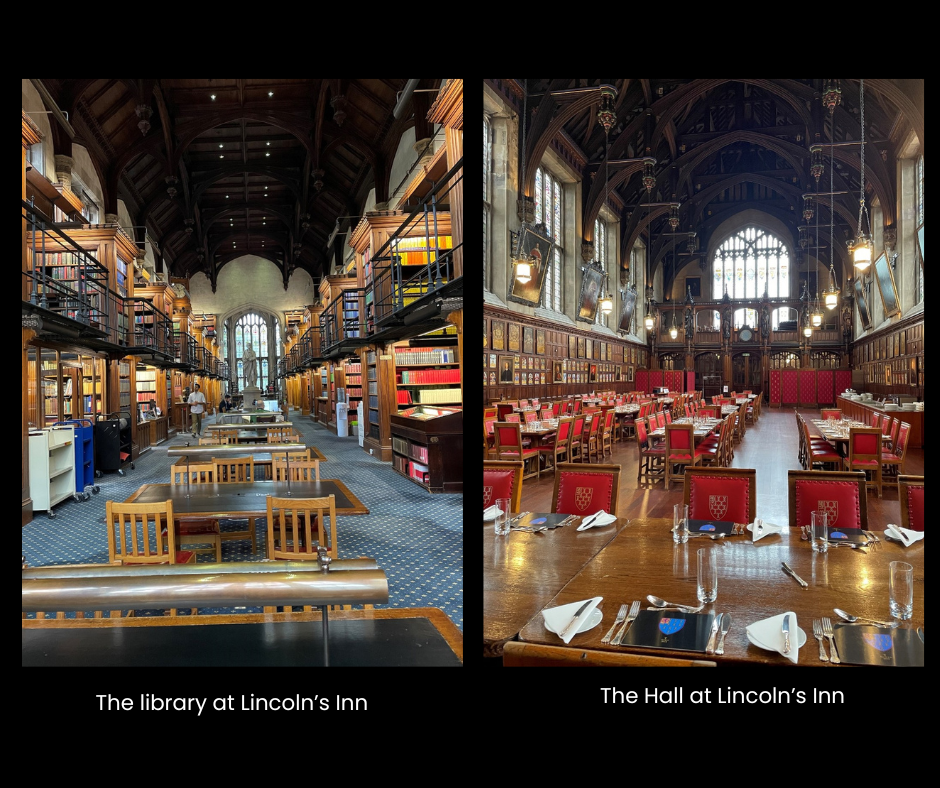Visiting the Inns of Court

A blog post by Philippe Espinasse
In 2024, Philippe Espinasse visited all of the four Inns of Court in London. In this blog post, he discusses how each has retained its own peculiar character, and how aspiring barristers can apply to one.
Last year, I took the opportunity of a week-long trip to London to visit all of the four Inns of Court: The Honourable Societies of Gray’s Inn, Lincoln’s Inn, the Inner Temple, and the Middle Temple.
The Inns are exclusively entitled to Call their members to the Bar of England and Wales. While the Bar Course has been outsourced, and is now provided by various other organisations, they still play a significant role in the education of future barristers, not least through Qualifying Sessions, addressing advocacy skills; equality, diversity and inclusion; ethics, standards and values; legal knowledge, justice and the Rule of Law; and preparation for pupillage, career development, and wellbeing.
A visit to each of the Inns is free, and is easily planned by making contact in advance with their education department, the details of which can be found on their respective websites. For some Inns, the visits can be booked months in advance while for others, the deadline is much shorter. In addition, lunch in Hall is open to non-members at both Lincoln’s Inn and the Middle Temple, making for an interesting experience in what are, in both cases, some of the oldest edifices in London.
A typical visit will include a tour of some of the historical buildings (including an Inn’s library and Hall), education facilities, and a discussion of how to apply and (hopefully) secure a scholarship. Do note that most scholarships require a recipient to practice in England and Wales for several years after Call, so these may not necessarily be applicable to all overseas students (for which other types of scholarships beyond the Inns of Court may be available). One of the visits I made lasted for several hours; another only about 20 minutes.
All of the Inns do provide the same types of educational services (although the quantum of the scholarships offered differs) but each has a peculiar character. At the end of the day, which Inn of Court one decides to join ultimately very much depends on one’s preferences and “feelgood” factor.
Lincoln’s Inn, which dates from 1422, is the largest of all four Inns, with extensive grounds, an amazing old library, and a rather large gothic church with tall, stained-glass windows. There is a restaurant (with a terrace in the summer) which is open to all, so well-worth taking advantage of. Most of the (largely underground) student facilities, however, were recently refurbished and have a more modern, businesslike feel.
.png)

By contrast, Gray’s Inn (whose records go back to 1388) is the smallest of the Inns. The set up is through a series of courtyards with most of the buildings actually occupied by tenants (as is in fact the case at the other Inns). There are comparatively fewer historic parts to visit there, and the feel is more that of a tight-knit community.
The Middle Temple (dating back to 1622) and the Inner Temple are in effect intertwined. They however could not be more different from one another. Both are linked to the Knights Templar (the Temple Church, likely one of, if not the oldest one in London, was consecrated in 1185).
Middle Temple retains many historic buildings and artefacts (and is a bit of a maze), including a very impressive Hall, which is open to non-members for lunch (which can easily be booked on the Inn’s website).
On the other hand, the Inner Temple suffered much destruction during World War II, and was largely rebuilt in the 1950s. As a consequence, it has a very modern feel throughout. It however features an attractive restaurant, with a quiet outside terrace. At both the Inner and Middle Temple, there are extensive gardens gently sloping down towards the Embankment.
%20(1).png)
Ultimately, one can only apply to one of the Inns. This can be done prior to graduating (which is actually encouraged), as I did. The process is very straightforward and, even though the website said this would take a number of weeks, I was confirmed as a student member within a few days only.
Just looking at the websites, I thought I had made up my mind on which Inn to join, but the visits I made changed that, and, ultimately, I ended up applying to a different one.
I have now already attended several qualifying sessions (some of which are held online, although six of the required ten do require attendance in person). These were all on the subject of legal research and arranged by the Inn’s library (which owns a treasure trove of precious, very old volumes), and were actually most helpful for the remainder of my studies at the OU. Many of the students joining me for these sessions were from a variety of jurisdictions, including from Asia and the Caribbean, not all of which ultimately plan to practice in the UK.
Overall, visiting the Inns of Court is well worth doing (even if one does not ultimately intend to qualify as a barrister). Also interesting is the whole ecosystem that exists alongside (and close to) the Inns themselves, including legal bookshops, legal tailors, and legal-themed pubs (featuring many wigs, gowns, and old books!).
The Inns of Court are still very much seeped in history and joining one remains an important decision, definitely best made after visiting in person.